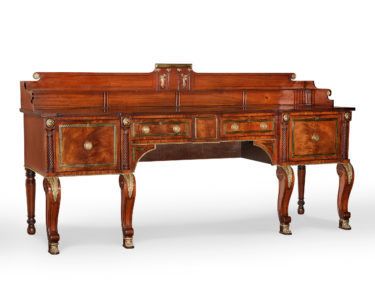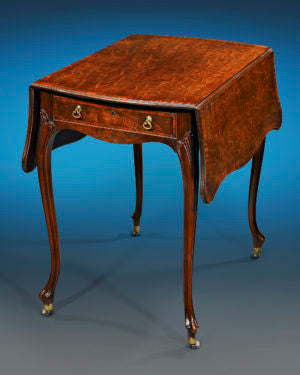Beloved for its aesthetic beauty and exceptionally high quality, Georgian furniture is arguably the most sought-after and enduring furniture in British history. At M.S. Rau, we offer a number of stunning Georgian masterpieces (including furniture) in our collection that feature many of the Georgian style furniture characteristics. If you're curious about how to identify antique tables and furniture, our resource center can help you make sure you know how to tell an authentic antique furniture piece from a fake. To learn more about this 18th century furniture style, read on below.

Crafted of mahogany, this sideboard from the Regency period features an elegant Neoclassical design.
THE GEORGIAN ERA
As the exquisite predecessor to the Victorian era and Victorian furniture, the Georgian Era (1714-1830), is a period of British history marked by the reigns of George I, George II, George III, and George IV, the first four Hanoverian kings of Great Britain. Romantic style Victorian era antiques are among some of our most requested pieces of fine jewelry for sale. A period of peace and prosperity spanning over a century, the Georgian period saw a great increase in innovation, an expansion of the already powerful British Empire, and a flowering of literary and visual arts and architecture.
STYLISTIC EVOLUTION OF GEORGIAN FURNITURE
Two factors heavily influenced the stylistic evolution seen in Georgian furniture design, Georgian art, and Georgian architecture during this era: a renewed interest in ancient Greek and Roman art and architecture and the importation and popularization of mahogany.
The influence of classical antiquity is most evident in the Palladian furniture style (sometimes called Georgian Palladian) of the early to mid-Georgian era. The luxurious style of Palladian furniture, often massive in scale and extravagantly gilded with cabriole legs, was intended to furnish England’s country homes, mansions, and palaces. From a dining table to a dining chair, this style was popularized primarily by the designs of furniture maker William Kent. It is highly likely that the growing number of young wealthy Englishmen traveling to Italy for a Grand Tour ultimately led to the incorporation of classic Greek and Roman elements into a new English furniture design of the period.
During the early 18th century, Georgian style furniture was deeply rooted in Dutch and French fashions of the previous century, with walnut reigning supreme as the wood of choice. However, when walnut trees became diseased, manufacturers had to import mahogany from the West Indian colonies. The exotic, dark wood can be polished to a high degree, lending itself to the crisp edges, architectural lines, and Italianate shapes that emerged in the Georgian Era—mahogany quickly became the wood of choice!
Urbanization and societal changes also influenced (although to a lesser degree) Georgian style furniture. For example, in previous centuries, tables and chairs (especially dining room chairs) were pushed back against the wall when not in use. Therefore, the backs of chairs were typically quite plain—people would no more pay for hidden decoration than they would now! However, in the 18th century, during the early Georgian period, life became less formal, and permanent sitting areas became fixtures in the home. In response to this development, the backs of a typical Georgian chair began to feature intricate carving and inlay, making the piece appear beautiful when viewed from any angle. The elaborate carving and detailing design of Georgian furniture pieces and historical chairs completely transformed English furniture and brought forth a new interior design style that exudes fine elegance.
INFLUENTIAL CABINETMAKERS: KENT, CHIPPENDALE, HEPPLEWHITE, & SHERATON
Of all English cabinetmakers working within the Georgian era, four furniture designers surpass the rest: William Kent, Thomas Chippendale, George Hepplewhite, and Thomas Sheraton.

This exquisite pair of console tables were crafted in the manner of William Kent
William Kent (1686-1748)
- Monumental, heavy overall appearance
- Influenced primarily by classical art and architecture of Rome
- Embellished by ornate carvings, excessive gilding
- Common decorative motifs include columns, scallop shells, pediments, and masks
- Designs are marked by symmetry and balance

This highly important Pembroke table was crafted by the iconic Thomas Chippendale
Thomas Chippendale (1718-1779)
-Chippendale style furniture had a refined, elegant overall appearance
- Elements of Rococo, Gothic, and Chinese styles are incorporated harmoniously
- Embellished with carvings
- Chairs and sofas upholstered with rich brocades, velvets, and damasks
- Cabriole legs with ball and claw feet are typical

This 18th-century Georgian antique sideboard displays the hallmarks of quality George Hepplewhite design
George Hepplewhite (1727-1786)
- Graceful overall appearance
- Pieces may be embellished with carvings, painted designs, inlay, or contrasting veneers
-Common neoclassical motifs include swags, ribbons, feathers, urns, and plants
- Pieces are geometric in shape, particularly curved or circular
- May feature “tambours” or vertical strips of wood glued to a heavy cloth
- Legs and feet are typically simple

Sumptuous satinwood distinguishes this wonderful Sheraton Revival dressing table and chair
Thomas Sheraton (1751-1806)
- Light, delicate overall appearance
- Embellished with low-relief carvings, the art of marquetry, or contrasting veneers
- Common neoclassical motifs include swags, ribbons, lyres, feathers, urns, and flowers
- Pieces are typically geometric in shape, particularly square or rectangular
- Slender legs may be straight or tapered
This blog post is the third and final installment of a three-part series which explores the flowering of the arts during the Georgian Era (1714-1830) and serves as a supplement to “House of Hanover: The Georgian Collection” currently on display at M.S. Rau Antiques.







